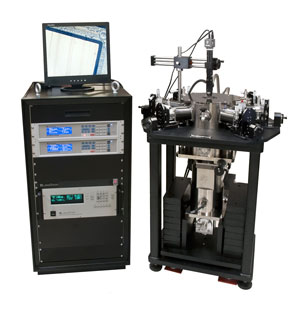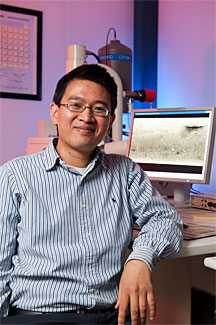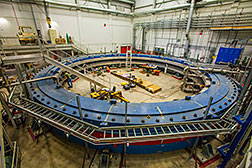
niobium-3-tin produced a record field
of 11.5 Tesla.
A superconducting magnet developed and fabricated at DOE’s Fermi National Accelerator Laboratory reached its design field of 11.5 Tesla at a temperature nearly as cold as outer space. It is the first successful twin-aperture accelerator magnet made of niobium-3-tin in the world.
Niobium-3-tin, or Nb3Sn, is brittle and requires high-temperature processing. Scientists only could achieve the latest milestone after decades of worldwide R&D efforts both in the Nb3Sn conductor itself and in associated magnet technologies.
Superconducting magnets are at the heart of many particle accelerators for fundamental science and have other scientific and technological applications. Thanks to Nb3Sn’s stronger superconducting properties, the alloy enables magnets of larger field than any in current particle accelerators. As a comparison, the niobium-titanium dipole magnets built in the early 1980s for the Tevatron particle collider produced about 4 Tesla. The most powerful niobium-titanium magnets used in the Large Hadron Collider operate at roughly 8 Tesla. The new niobium-3-tin magnet creates a significantly stronger field.
The advancements in Nb3Sn magnet technology and the ongoing US collaboration with CERN on the development of these and other Nb3Sn magnets are enabling the use of this innovative technology for future upgrades of the Large Hadron Collider. They may also provide the cornerstone for other particle accelerators.
The 15-year investment in Nb3Sn technology at Fermilab has established a strong foundation for the planned LHC luminosity upgrade. Four DOE national laboratories — Berkeley Lab, Brookhaven Lab, Fermilab and SLAC—are involved in the US LHC Accelerator Research Program (LARP), which plays a key role in continued U.S. leadership in superconducting magnet technology for future particle physics programs.



